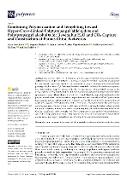Combining Polymerization and Templating toward Hyper-Cross-Linked Poly(propargyl aldehyde)s and Poly(propargyl alcohol)s for Reversible H2O and CO2 Capture and Construction of Porous Chiral Networks

Author
Publication date
2023Published in
PolymersVolume / Issue
15 (3)ISBN / ISSN
ISSN: 2073-4360Funding Information
UK//SVV260688
UK/COOP/COOP
GA0/GA/GA21-02183S
MSM//EF19_073/0016935
UK/UNCE/SCI/UNCE/SCI/014
Metadata
Show full item recordCollections
This publication has a published version with DOI 10.3390/polym15030743
Abstract
Two series of hyper-cross-linked microporous polyacetylene networks containing either -[CH=C(CH=O)]- or -[CH=C(CH2OH)]- monomeric units are reported. Networks are prepared by chain-growth copolymerization of acetal-protected propargyl aldehyde and acetal-protected propargyl alcohol with a 1,3,5-triethynylbenzene cross-linker followed by hydrolytic deprotection/detemplating. Deprotection not only liberates reactive CH=O and CH2OH groups in the networks but also modifies the texture of the networks towards higher microporosity and higher specific surface area. The final networks with CH=O and CH2OH groups attached directly to the polyene main chains of the networks have a specific surface area from 400 to 800 m(2)/g and contain functional groups in a high amount, up to 9.6 mmol/g. The CH=O and CH2OH groups in the networks serve as active centres for the reversible capture of CO2 and water vapour. The water vapour capture capacities of the networks (up to 445 mg/g at 297 K) are among the highest values reported for porous polymers, making these materials promising for cyclic water harvesting from the air. Covalent modification of the networks with (R)-(+)-3-aminopyrrolidine and (S)-(+)-2-methylbutyric acid enables the preparation of porous chiral networks and shows networks with CH=O and CH2OH groups as reactive supports suitable for the anchoring of various functional molecules.
Keywords
porous polymers, hyper-cross-linked, polyacetylenes, chiral modification, water harvesting
Permanent link
https://hdl.handle.net/20.500.14178/2079License
Full text of this result is licensed under: Creative Commons Uveďte původ 4.0 International







